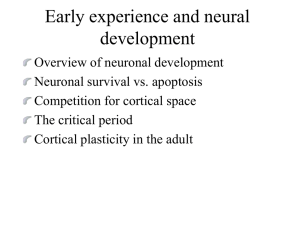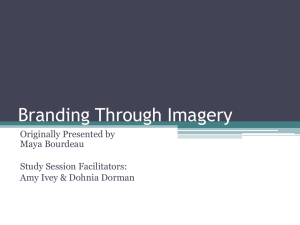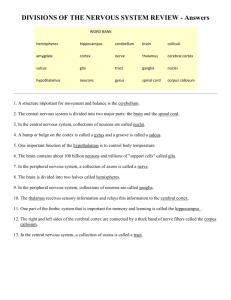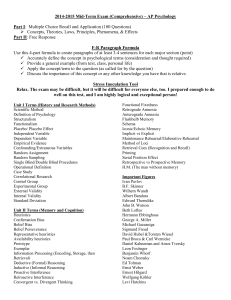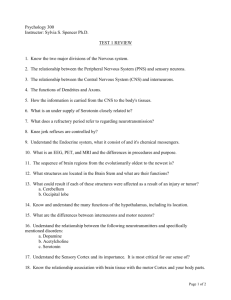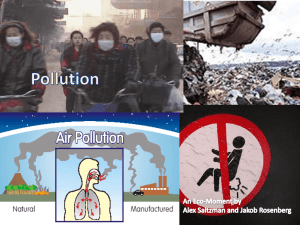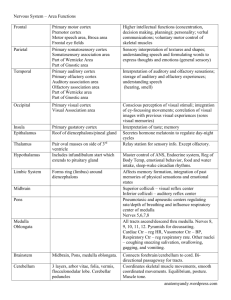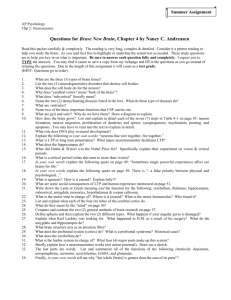nc 08 Maps
advertisement
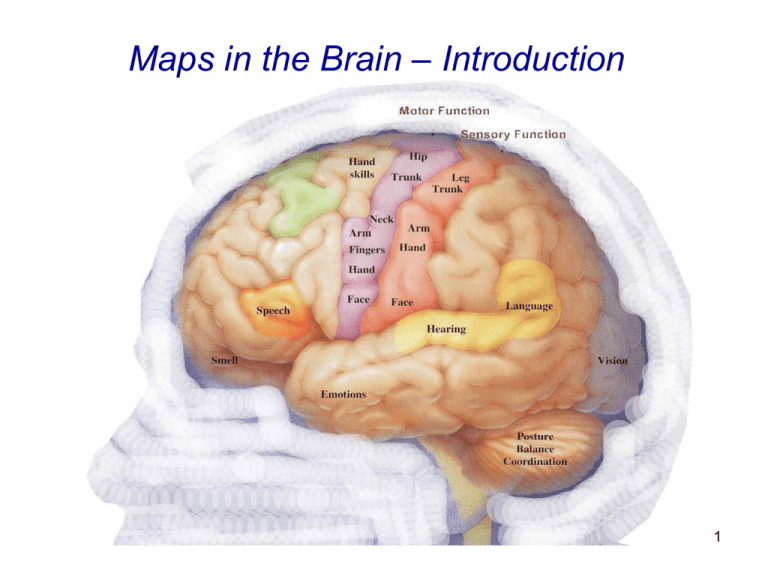
Maps in the Brain – Introduction 1 Overview A few words about Maps Cortical Maps: Development and (Re-)Structuring Auditory Maps Visual Maps Place Fields 2 What are Maps I Intuitive Definition: Maps are a (scaled) depiction of a certain area. Location (x,y) is directly mapped to a piece of paper. Additional information such as topographical, geographical, political can be added as colors or symbols. 3 What are Maps I Intuitive Definition: Maps are a (scaled) depiction of a certain area. Location (x,y) is directly mapped to a piece of paper. Additional information such as topographical, geographical, political can be added as colors or symbols. Important: A map is always a reduction in complexity. It is a REDUCED picture of reality that contains IMPORTANT aspects of it. What is important? That is in the eye of the beholder... 4 What are Maps II Mathematical Definition: Let W be a set, U a subset of W and A metric space (distances are defined). Then we call f a map if it is a one-to-one mapping from U to A. f: U -> A Example: The surface of the world (W) is a 2D structure embedded in 3D space. It can be mapped to a 2D euclidean space. In a mathematical sense a map is an equivalent representation of a complex structure (W) in a metric space (A), i.e. it is not a reduction – the entire information is preserved. 5 Cortical Maps Cortical Maps map the environment onto the brain. This includes sensory input as well as motor and mental activity. Example: Map of sensory and motor representations of the body (homunculus).The more important a region, the bigger its map representation. Scaled “remapping” to real space 6 Spatial Maps Place Cells 7 What are place cells? • Place cells are the principal neurons found in a special area of the mammal brain, the hippocampus. • They fire strongly when an animal (a rat) is in a specific location of an environment. • Place cells were first described in 1971 by O'Keefe and Dostrovsky during experiments with rats. • View sensitive cells have been found in monkeys (Araujo et al, 2001) and humans (Ekstrom et al, 2003) that may be related to the place cells of rats. 8 The Hippocampus Human hippocampus 9 The Hippocampus Human hippocampus Rat hippocampus 10 11 12 Hippocampus Place cells Visual Olfactory Auditory Taste Somatosensory Self-motion • • • • • Hippocampus involved in learning and memory All sensory input into hippocampus Place cells in hippocampus get all sensory information Information processing via trisynaptic loop How place are exactly used for navigation is unknown 13 Place cell recordings 1. 1. Electrode array is inserted to the brain for simultaneous recording of several neurons. 14 Wilson and McNaughton, 1993 Place cell recordings 1. 2. 1. Electrode array is inserted to the brain for simultaneous recording of several neurons. 2. The rat moves around in a known/unknown environment. 15 Wilson and McNaughton, 1993 Place cell recordings 1. 3. 2. 1. Electrode array is inserted to the brain for simultaneous recording of several neurons. 2. The rat moves around in a known/unknown environment. 3. Walking path and firing activity (cyan dots). 16 Wilson and McNaughton, 1993 Place Field Recordings y Terrain: 40x40cm y x Single cell firing activity x Map firing activity to position within terrain Place cell is only firing around a certain position (red area) Cell is like a “Position Detector” 17 Place fields 40x40cm Array of cells Ordered for position of activity peak (top left to bottom right) O’Keefe, 1999 18 Place fields 40x40cm Array of cells Ordered for position of activity peak (top left to bottom right) Different shapes: Circular Islands O’Keefe, 1999 19 Place fields 40x40cm Array of cells Ordered for position of activity peak (top left to bottom right) Different shapes: Circular Islands Twin Peaks O’Keefe, 1999 20 Place fields 40x40cm Array of cells Ordered for position of activity peak (top left to bottom right) Different shapes: Circular Islands Twin Peaks Elongated O’Keefe, 1999 21 Place fields 40x40cm Array of cells Ordered for position of activity peak (top left to bottom right) Different shapes: Circular Islands Twin Peaks Elongated Not Simple (=> not published) O’Keefe, 1999 22 How do place cells develop? Allothetic (external) sensory input Visual Olfactory (around 1000 receptors in rat, whereas humans have 350) Somatosensory (via whiskers) Auditory (rat range 200Hz-90KHz, human range 16Hz-20KHz) Idiothetic (internal) sensory input Self motion (path integration, mostly used then allothetic information is not available) Not so reliable by itself since no feedback 23 Importance of visual cues Experiment: Environment with landmark (marked area) => record activity from cell 1 and 2 Observation: Place fields develop 24 Knierim, 1995 Importance of visual cues Experiment: Environment with landmark (marked area) => record activity from cell 1 and 2 Observation: Place fields develop Step 2: Rotate landmark => place fields rotate respectively Conclusion: Visual cues are used for formation of place fields 25 Knierim, 1995 Place Cell Remapping Brown plastic square box and white wooden circle box was used to show place cell remapping phenomena: •Cells 1-5 show increasing divergence between the square and circle box; •Cells 6-10 show differentiation from the beginning; •Some cells chow common representation or do not remap at all (not shown). Wills et al, 2005, Science 26 Importance of olfactory cues Fact: Rats use their urine to mark environment Experiment: Two sets, one in light and one in darkness; remove self-induced olfactory cues and landmarks (S2-S4) Result: Without olfactory cues stable place fields (control S1) change or in darkness even deteriorate. When olfactory cues are allowed again (control S5), place fields reemerge. Light/Cleaning Dark/Cleaning 27 Save, 2000 Place cell model Use neuronal network to model formation of place cells 28 Place cell model Use neuronal network to model formation of place cells Input layer for allothetic sensory input depending on position in simulated world 4 Visual cues (landmarks) 29 Place cell model Use neuronal network to model formation of place cells Input layer for allothetic sensory input depending on position in simulated world 4 Visual cues (landmarks) 4 Olfactory cues (environmental) 30 Place cell model Use neuronal network to model formation of place cells Input layer for allothetic sensory input depending on position in simulated world 4 Visual cues (landmarks) 4 Olfactory cues (environmental) Output layer, n x n simulated neurons, each of which is connected to all input neurons (fully connected feed-forward) 31 Place cell model Use neuronal network to model formation of place cells Input layer for allothetic sensory input depending on position in simulated world 4 Visual cues (landmarks) 4 Olfactory cues (environmental) Output layer, nxn simulated neurons, each of which is connected to all input neurons (fully connected feed-forward) After learning => formation of place fields 32 Place cell model Use neuronal network to model formation of place cells Input layer for allothetic sensory input depending on position in simulated world 4 Visual cues (landmarks) 4 Olfactory cues (environmental) Output layer, nxn simulated neurons, each of which is connected to all input neurons (fully connected feed-forward) After learning => formation of place fields The know-how is in the change of the connection weights W ... 33 Mathematics of the model Firing rate r of Place Cell i at time t is modeled as Gaussian function: σf is width of the Gaussian function, X and W are vectors of length n, ||* || is the euclidean distance 34 Mathematics of the model Firing rate r of Place Cell i at time t is modeled as Gaussian function: σf is width of the Gaussian function, X and W are vectors of length n, ||* || is the euclidean distance At every time step only on weight W is changed (Winner-Takes-All), i.e. the neuron with the strongest response is changed: 35 Place fields A) Visual input => unique round place fields, because the distances to the walls are unique (no multipeaks) B) Olfactory input => place fields not round, because input is complex (gradients not well structured) C) Combined input is a mixture of both 36 Place field remapping 37 Maps of More Abstract Spaces 38 Visual cortex Visual cortex Cortical Mapping Retinal (x,y) to complex log coordinates The complex logarithmic transform a = c + ib Retinal Space Complex log Concentric Circles (expon. Spaced) Vertical Lines (equally spaced) Radial Lines (equal angular spacing) Horizontal Lines (equally spaced) log(a) = log(c + ib) In Polar Coordinates a = r exp(if) b f c Cortical Mapping retinal (x,y) to log Z Coordinates On „Invariance“ A major problem is how the brain can recognize object in spite of size and rotation changes! Real Space log Z Space Concentric Circles (expon. Spaced) Vertical Lines (equally spaced) Scaling and Rotation defined in Polar Radial Lines Coordinates: (equal angular spacing) Scaling A = k r exp(if) = k a a = r exp(if) Scaling constant Rotation A = exp(ig) r exp(if) = r exp(i[f+g]) = a exp(ig) Rotation angle After log Z transform we get: Scaling: log(ka) = log(k) + log(a) Rotation: log(a exp(ig)) = ig + log(a) Horizontal Lines (equally spaced) Some more details G(z) = log z+a z+b z=x + iy a and b take the values 0.333 and 6.66 respectively. Visual cortex 46 Visual Cortex Primary visual cortex or striate cortex or V1. Well defined spacial representation of retina (retinotopy). 47 Visual Cortex Primary visual cortex or striate cortex or V1. Well defined spacial representation of retina (retinotopy). Prestriate visual cortical area or V2 gets strong feedforward connection from V1, but also strongly projects back to V1 (feedback) Extrastriate visual cortical areas V3 – V5. More complex representation of visual stimulus with feedback from other cortical areas (eg. attention). 48 Receptive fields Cells in the visual cortex have receptive fields (RF). These cells react when a stimulus is presented to a certain area on the retina, i.e. the RF. Simple cells react to an illuminated bar in their RF, but they are sensitive to its orientation (see classical results of Hubel and Wiesel, 1959). Bars of different length are presented with the RF of a simple cell for a certain time (black bar on top). The cell's response is sensitive to the orientation of the bar. 49 On-Off responses Experiment: A light bar is flashed within the RF of a simple cell in V1 that is recorded from. Observation: Depending on the position of the bar within the RF the cell responds strongly (ON response) or not at all (OFF response). 50 On-Off responses Experiment: A light bar is flashed within the RF of a simple cell in V1 that is recorded from. Observation: Depending on the position of the bar within the RF the cell responds strongly (ON response) or not at all (OFF response). Explanation: Simple cell RF emerges from the overlap of several LGN cells with center surround RF. 51 Columns Experiment: Electrode is moved through the visual cortex and the preference orientation is recorded. Observation 1: Preferred orientation changes continuously within neighboring cells. 52 Columns Experiment: Electrode is moved through the visual cortex and the preference orientation is recorded. Observation 1: Preferred orientation changes continuously within neighboring cells. Observation 2: There are discontinuities in the preferred orientation. 53 2d Map Colormap of preferred orientation in the visual cortex of a cat. One dimensional experiments like in the previous slide correspond to an electrode trace indicated by the black arrow. Small white arrows are VERTICES where all orientations meet. 54 Ocular Dominance Columns The signals from the left and the right eye remain separated in the LGN. From there they are projected to the primary visual cortex where the cells can either be dominated by one eye (ocular dominance L/R) or have equal input (binocular cells). 55 Ocular Dominance Columns The signals from the left and the right eye remain separated in the LGN. From there they are projected to the primary visual cortex where the cells can either be dominated by one eye (ocular dominance L/R) or have equal input (binocular cells). White stripes indicate left and black stripes right ocular dominance (coloring with desoxyglucose). 56 Ice Cube Model Columns with orthogonal directions for ocularity and orientation. 57 Hubel and Wiesel, J. of Comp. Neurol., 1972 Ice Cube Model Columns with orthogonal directions for ocularity and orientation. Problem: Cannot explain the reversal of the preferred orientation changes and areas of smooth transitions are overestimated (see data). 58 Hubel and Wiesel, J. of Comp. Neurol., 1972 Graphical Models Preferred orientations are identical to the tangents of the circles/lines. Both depicted models are equivalent. Vortex: All possible directions meet at one point, the vortex. Problem: In these models vortices are of order 1, i.e. all directions meet in one point, but 0° and 180° are indistinguishable. 59 Braitenberg and Braitenberg, Biol.Cybern., 1979 Graphical Models Preferred orientations are identical to the tangents of the circles/lines. Both depicted models are equivalent. Vortex: All possible directions meet at one point, the vortex. Problem: In these models vortices are of order 1, i.e. all directions meet in one point, but 0° and 180° are indistinguishable. From data: Vortex of order 1/2. 60 Braitenberg and Braitenberg, Biol.Cybern., 1979 Graphical Models cont'd In this model all vertices are of order 1/2, or more precise -1/2 (d-blob) and +1/2 (l-blob). Positive values mean that the preferred orientation changes in the same way as the path around the vertex and negative values mean that they change in the opposite way. 61 Götz, Biol.Cybern., 1988 Developmental Models Start from an equal orientation distribution and develop a map by ways of a developmental algorithm. Are therefore related to learning and self-organization methods. 62 Model based on differences in On-Off responses 63 KD Miller, J Neurosci. 1994 Resulting receptive fields Resulting orientation map Difference Correlation Function 64
